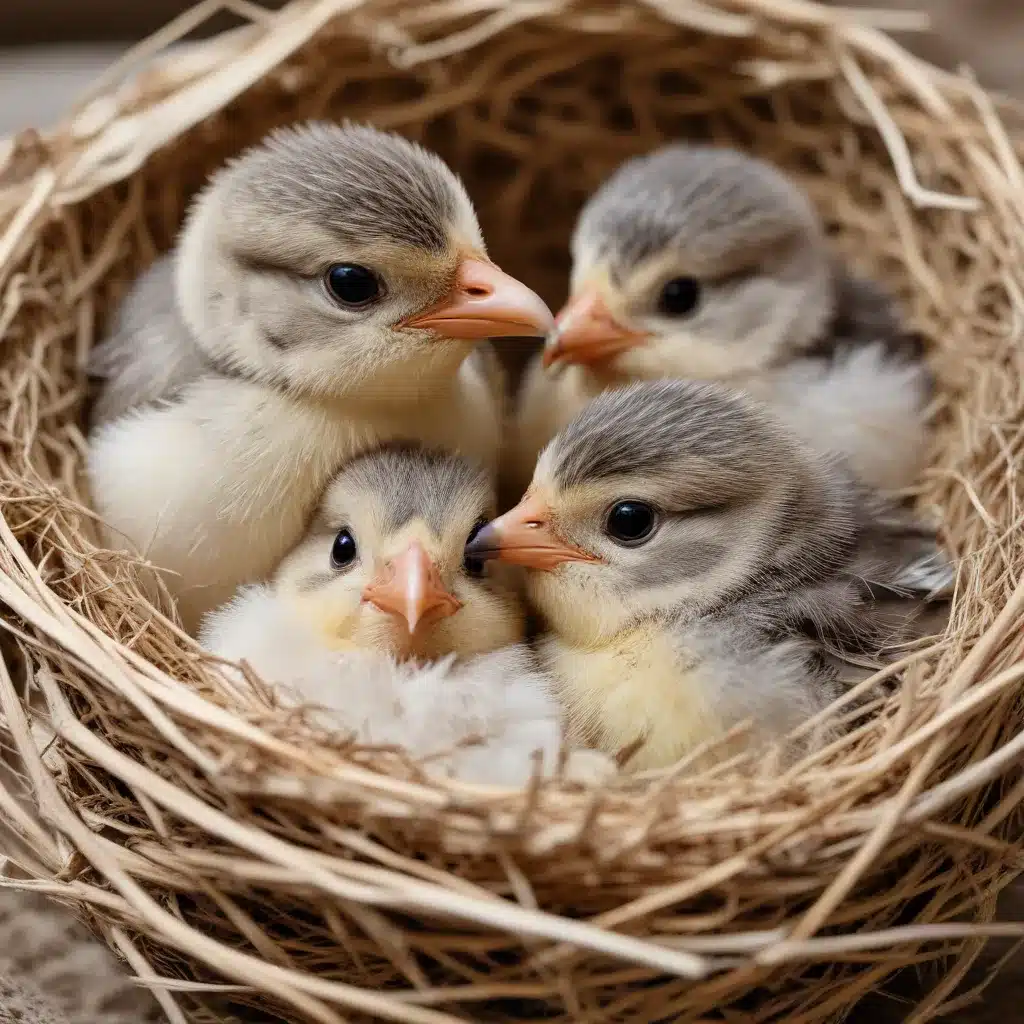
Nourishing Nestlings: Tailored Feeding Protocols for Raising Healthy Baby Birds
Nestling Nutrition
From the moment they hatch, baby birds have very specialized dietary needs. As an experienced avian caretaker, I know that providing the right nutrition is crucial for supporting their rapid growth and development. Nestlings require a delicate balance of proteins, fats, carbohydrates, vitamins, and minerals to thrive.
The specific nutrient profile depends on the species, but in general, young birds need a diet high in protein from insects, larvae, and small vertebrates. They also need plenty of calcium for strong bones and shells, as well as other key minerals like phosphorus, magnesium, and iron. Vitamins A, D, E, and the B-complex are equally important. Careful monitoring of intake and adjusting the diet accordingly is essential.
Feeding schedules for nestlings vary greatly, but most require frequent meals every 15-30 minutes during daylight hours. Younger hatchlings may need to be fed through the night as well. The amount provided at each feeding depends on the size and developmental stage of the chick. Overfeeding can be just as detrimental as underfeeding, so it’s crucial to follow species-specific guidelines.
Nesting Environments
Where and how baby birds are housed plays a big role in their overall health and wellbeing. The nest environment needs to closely mimic their natural habitat to meet their complex needs. Proper nest design, temperature, humidity, and substrate are all important considerations.
Some species prefer open-cup nests, while others thrive in enclosed, domed structures. Nesting material should be soft, insulating, and comfortable for the chicks. Maintaining the ideal microclimate – usually 90-100°F for hatchlings, decreasing to 70-80°F as they mature – is crucial for proper thermoregulation and growth.
Humidity levels between 50-70% help prevent dehydration and respiratory issues. Clean, fresh water must always be available, either through the parent birds or provided separately. Proper sanitation and frequent nest changes are a must to prevent the buildup of waste and harmful bacteria.
Developmental Stages
The care and feeding of baby birds varies greatly depending on their stage of development. Each phase requires specialized protocols to address their unique needs.
Hatchling Care
When birds first emerge from their eggs, they are completely dependent on their parents or caregivers. Hatchlings cannot regulate their own body temperature, so providing a warm, stable environment is the top priority. Proper brooding techniques, such as using a heat lamp or incubator, are essential.
Hydration is another critical concern, as newborn chicks lose a significant amount of water during the hatching process. Carefully monitoring intake and administering fluids as needed prevents dehydration. Avoid overhydration, which can also be detrimental.
Fledgling Support
As nestlings grow their flight feathers and begin venturing outside the nest, they enter the fledgling stage. This transitional period requires additional support to build their strength and skills for eventual independence.
Encouraging natural flight behaviors through gradual exercise and conditioning is key. Providing perches of varying heights and textures, as well as opportunities for short flights, helps strengthen their wing muscles. Gradually increasing the duration and intensity of these activities prepares them for the rigors of life in the wild.
Proper nutrition remains essential, but the diet may shift to incorporate more whole foods and fewer supplements. Monitoring their progress and adjusting the feeding regimen accordingly ensures a smooth transition to self-sufficiency.
Feeding Protocols
Crafting the ideal feeding protocols for baby birds involves a deep understanding of their species-specific nutritional needs and developmental stages. A one-size-fits-all approach simply doesn’t work.
Specialized Formulas
Commercially available hand-rearing formulas provide a convenient and balanced solution for feeding nestlings and fledglings. These specialized blends are carefully formulated with the appropriate ratio of proteins, fats, carbohydrates, vitamins, and minerals.
When selecting a formula, pay close attention to the age-appropriate nutrient profile. Hatchlings have different requirements than older chicks nearing the fledgling stage. Supplemental enrichments like probiotics, omega-3s, and antioxidants can also be beneficial, depending on the individual bird’s needs.
Delivery Methods
The method of feeding is just as important as the food itself. Handfed chicks require a delicate touch and specialized techniques to ensure they receive the proper amount without aspiration or injury. Syringe, spoon, or tube feeding are common approaches, with the caregiver carefully monitoring intake.
For those unable to provide hands-on feeding, automated feeders offer a convenient alternative. These devices dispense precise portions at regular intervals, mimicking the frequency of parental care. Proper setup, maintenance, and monitoring are crucial to prevent issues like clumping, spoilage, and waste.
Conservation Implications
Beyond the basics of avian caregiving, there is a growing emphasis on the role that responsible breeding and rehabilitation programs play in species conservation efforts. Providing the best possible care for baby birds has far-reaching impacts.
Reintroduction Programs
Many endangered or threatened bird species are the focus of intensive captive breeding and reintroduction initiatives. Ensuring that these nestlings and fledglings receive the highest standard of nutrition and support is essential for their successful release and integration into the wild.
Post-release monitoring and habitat restoration are equally crucial components of these conservation efforts. Tracking the birds’ progress, health, and survival rates informs future protocols and helps identify areas for improvement.
By prioritizing the unique needs of baby birds, both in captivity and in the wild, we can make meaningful strides in protecting vulnerable avian populations. Responsible avian caregiving is not just about individual birds, but about safeguarding the future of entire species.
As an experienced avian caretaker, I’ve seen firsthand the profound impact that tailored feeding protocols and attentive nesting environments can have on the health and development of baby birds. By staying up-to-date on the latest research and best practices, we can ensure that the next generation of our feathered friends gets the best possible start in life.


